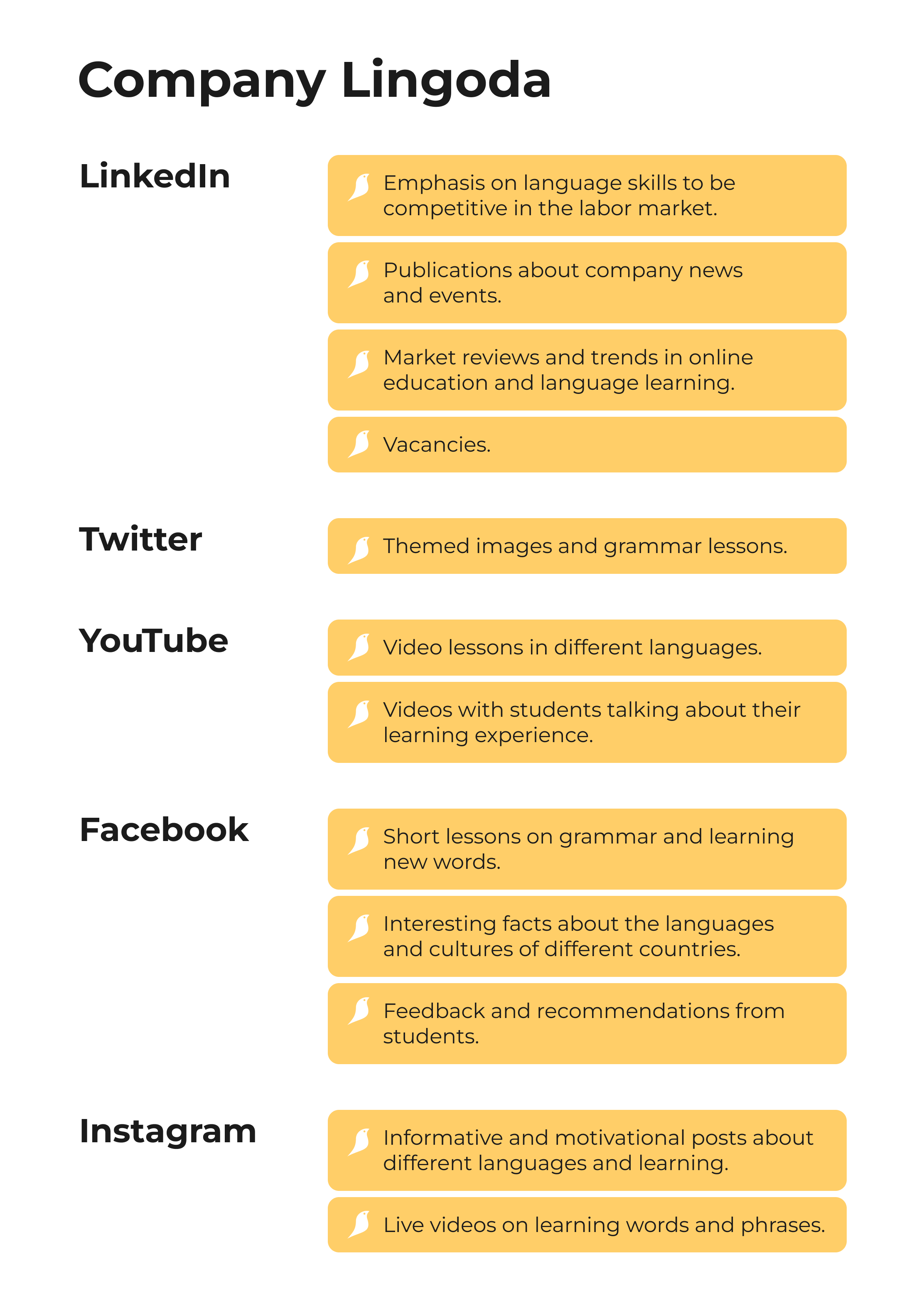Do you have a ready-made product but don’t know which markets it can be successfully launched in? A marketing analysis will help you. It will help you find out:
— where there is the greatest demand for your product;
— what factors are responsible for this;
— what competitors are present in a particular market, and much more.
In this case, we will share with you how our remote marketing department conducted a marketing analysis, found the most promising markets, and created a marketing strategy for an online language school startup.
Project CMO — Kristina Gladunova.
Our service is a remote marketing department — marketing analysis.
Case study navigation
- Our team
- Stage one. Introductory consultation
- Stage two. Marketing research
- Stage three. Website analysis
- Stage four. Analysis of social networks
- Stage five. Basic strategy
- Results of the work
Approximate time to read the case — 15 minutes
Our team
To conduct a marketing analysis, we form a team of specialists who will be able to fulfill the tasks.
Stage one. Introductory consultation
Depending on the stage of development of a startup, whether it is a business idea or an existing finished product, its needs will differ. This also affects the specifics of the marketing analysis, which is what we will focus on the most.
Therefore, before starting the research, we always hold an introductory consultation with our client, during which they fill out a brief. This process helps us to better understand the project, its product, and relevant needs.
Today we are going to tell you about a client who contacted us — an online language school startup — MERIOKS LANGUAGE CENTER.

In this case, the client’s need is to find more promising markets to promote an existing product with a set price. Therefore, during the marketing analysis, we focused on market research, namely the European market.
Stage two. Market research
After we had learned more about the project and the client’s needs, we immediately started looking for countries with a high demand for learning the required languages — English, Spanish, and Chinese. We also analyzed market trends, consumer behavior, competitors, and pricing.
We’ll tell you more about how we did it using the example of one of our services — English.
Step 1. Search for countries with high and low English proficiency
We have found out that Europeans rank first in the world in terms of English language proficiency. This is because most of the countries in this region are multinational, and people need to speak the same language to fill the need for communication.
The second reason is international companies that require their employees to know English in order to cooperate, in particular with other large global corporations.
To find out where English learning might be popular, we analyzed European countries with high and low levels of the language.
Thus, the record holders in the study and use of English are the Netherlands, Austria, Norway, Denmark, Belgium, Sweden, Finland, Portugal, Germany, and Croatia. And the lowest English language proficiency rates among European countries in 2022, according to the EF (EPI) index, is observed in Italy, Spain, and France.
Step 2. Analyze demand, competitors, and trends in English language learning
Market trend research is an important step in conducting marketing analysis for any business. It allows you to:
- predict the demand for your product or service;
- identify opportunities for development;
- obtain information about changes in consumer behavior;
- stand out among competitors and take a leading position in the market.
Therefore, when conducting our marketing analysis, we studied not only countries with demand for English, but also existing trends and tendencies in the market of educational language products.
For example, the number of adults enrolling in long-term regular evening or weekend courses is declining. Instead, there is a growing demand for short-term specialized courses where students can learn at a convenient format and pace.
As a result of our research of the European market, we have found that there are 3 countries where there is currently a high demand for English, political support for its learning, and geographical location (lack of a large number of English speakers): Poland, France, and Spain.
We have analyzed each of these countries in more detail:
- official language;
- percentage of residents who speak English;
- regions and cities with high/low language proficiency;
- gender distribution of English proficiency;
- language learning in educational institutions;
- percentage of consumers with access to the Internet;
- political factors that influence language learning;
- identification and review of competitors — language providers represented in the market;
- trends in the use of their services;
- and more.
Step 3. Price analysis
Before launching a product or service in a particular market, it is important to analyze competitors’ prices and offers in order to find out:
— how much the target audience will be willing to pay for your product;
— what prices should be set to attract local consumers and cover related costs.
Also, when entering new markets, prices should be adapted by currency and different forms of payment should be available.
So that the client could further take into account the above factors, we analyzed the cost of individual and group English classes in the context of the countries of interest and compared them with the pricing policy of our project.
Thus, we found that the average price for group lessons was $14 per hour, which is significantly higher than the cost of the MERIOKS service — $6.55 per hour.
At the same time, the average price for individual lessons is $23.38 per hour, which is lower than the cost of the client’s service — $29.9 per hour. Therefore, offering a course above the average pricing policy, you need to take care of the benefits of the service and justify them to the consumer.
Stage three. Analysis of the site
For a website to be truly effective, it must contain the following components:
- comprehensive, useful and interesting content;
- a clear structure: sections and subsections;
- modern and attractive design that is easy to perceive visually;
- adaptability to any device: from a PC to a mobile smartphone.
So we analyzed and provided recommendations in the following areas:
— content filling;
— desktop and mobile versions of the website;
— examples of competitors that may be useful in the future.
Stage four. Social media analysis
With the help of social media analysis, we sought to achieve the following goals:
- find out the current state of popularity of the client’s online language school and its competitors;
- identify the most popular content formats and topics;
- identify the potential audience of the project that should be engaged through social media.
Social media analysis of the project
At the time of the marketing analysis, MERIOKS LANGUAGE CENTER was represented on Facebook and Instagram. Therefore, we analyzed these pages according to the following criteria:
Activity. Over the past month and a half, this indicator has increased, but there was a long break in Instagram promotion before that. Therefore, thecoverage remains low, and the page is not included in the recommendation feed.
Followers. The number of followers on Instagram is satisfactory — more than 5,000, but they are inactive. Therefore, it is very important to focus on this, because if followers constantly respond to your posts, the page will be included in the recommendations of other social media users, which will help to increase popularity.
Interaction with the audience. There is no regular communication through stories, polls, quizzes, and live broadcasts. Without this, the audience may not understand the value of your product and therefore not buy it.
Type of content. There is a complete lack of people here. However, such content engages users 2-3 times more than regular images. This is especially important for Instagram promotion.
We also analyzed in more detail:
— Instagram profile header and company description on Facebook;
— highlights and their content;
— use of hashtags;
— texts of posts.
Analysis of competitors on social media
We explored the pages of the project’s competitors on social media and identified interesting details that can be used to further promote the online language school.
Here is an example of an analysis of one of the competitors:

According to the results of the competitors analysis, we came to the following conclusions:
- they use unique content;
- most of the publications are cross-posting of other posts about learning words;
- unique educational videos with charismatic speakers are created for YouTube;
- collaborations with other learning platforms are used;
- content is segmented by languages.
Content recommendations for the project
After analyzing the social media of the project and its competitors, we created the following list of recommendations for the client:
Tip №1. Use videos with professional teachers to ensure that the content is of high quality and causes trust among customers.
Tip №2. Create an interactive learning format with game elements to make it more engaging for students.
Tip №3. Make short videos with real people speaking a foreign language to show how to use it in everyday communication and make learning more organic.
Tip №4. Pay attention to the design and visuals of the content. Add some humanity to it to get more engagement and, consequently, more requests.
Tip №5. Collaborate with well-known teachers and language learning experts. This will give the platform additional authority.
Tip №6. Use various social networks to distribute your content and attract new students.
Target audience analysis
To determine who to target on social media, we researched the local target audience of competitors. Here are some examples:

Based on the information we received, we recommended the following steps to identify the target audience on social networks that might be interested in learning English, Spanish, or Chinese:
Step 1. Research which social network is the most popular among U.S. language learners. For example, studies show that young people aged 18-29 in the United States are actively using social networks such as Instagram and TikTok.
Step 2. Develop a detailed profile of your target audience, taking into account the following factors: age, level of education, profession, and interests.
Step 3. Find out what type of content is most popular among your target audience. For example, young people may be interested in short videos on social networks, such as TikTok and Instagram Reels. Adults, on the other hand, may be interested in interesting articles, webinars, and video tutorials on LinkedIn and Facebook. Youtube videos are relevant and effective for both audiences.
Step 4. Choose the social network that best suits your target audience and the type of content you will create.
Step 5. Create an advertising campaign on the chosen social network aimed at your target audience.
Step five. Basic strategy
As a result of our marketing analysis, we found countries with a high level of demand for English, Chinese, and Spanish. The next step is to enter and promote the startup in the relevant markets.
Therefore, to successfully realize these goals, we developed a basic marketing strategy that included:
— website development;
— optimization of social networks promotion;
— use of content marketing;
— SEO-promotion;
— attracting more reviews and working on reputation marketing;
— use of paid traffic acquisition channels;
— developing a personal brand for teachers.
Results of the work
As a result of conducting a marketing analysis for an online language school, the following was made:
Marketing research:
- search for countries with high and low levels of English proficiency;
- analysis of demand, competitors and market trends;
- price analysis.
Website analysis:
- filling with content;
- desktop version;
- mobile version;
- examples of competitors that may be useful.
Social media analysis:
- аnalysis of the project’s social networks of the project;
- analysis of competitors’ social networks, including their target audience.
Basic strategy:
- website;
- social networks;
- content marketing;
- SEO-promotion;
- lead generation;
- reputation marketing;
- personal brand of teachers.
Also, learn how we conducted marketing analysis for other startups with different needs. You can read them here and here.




